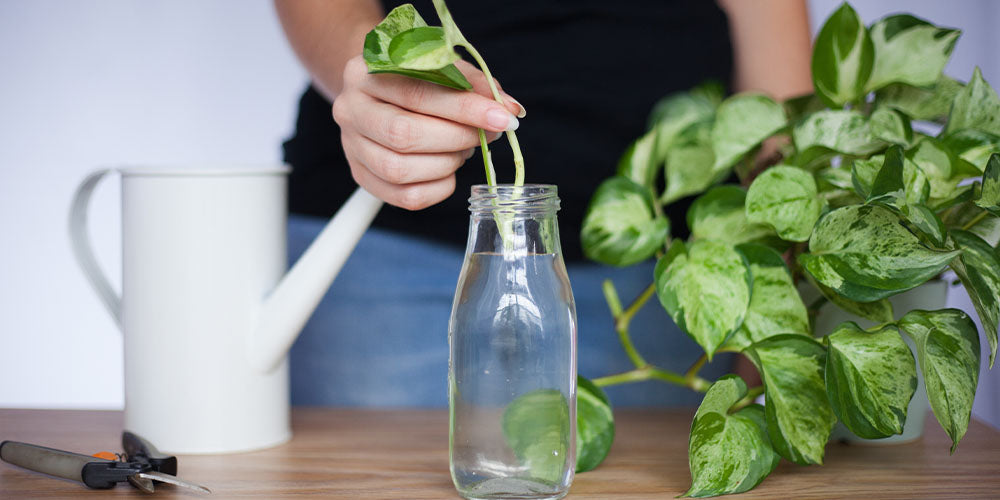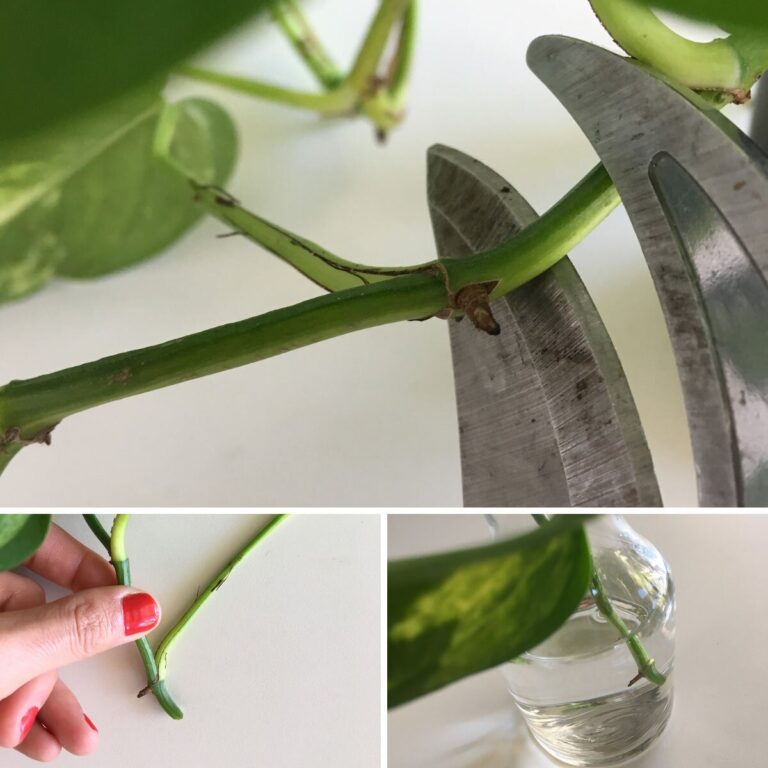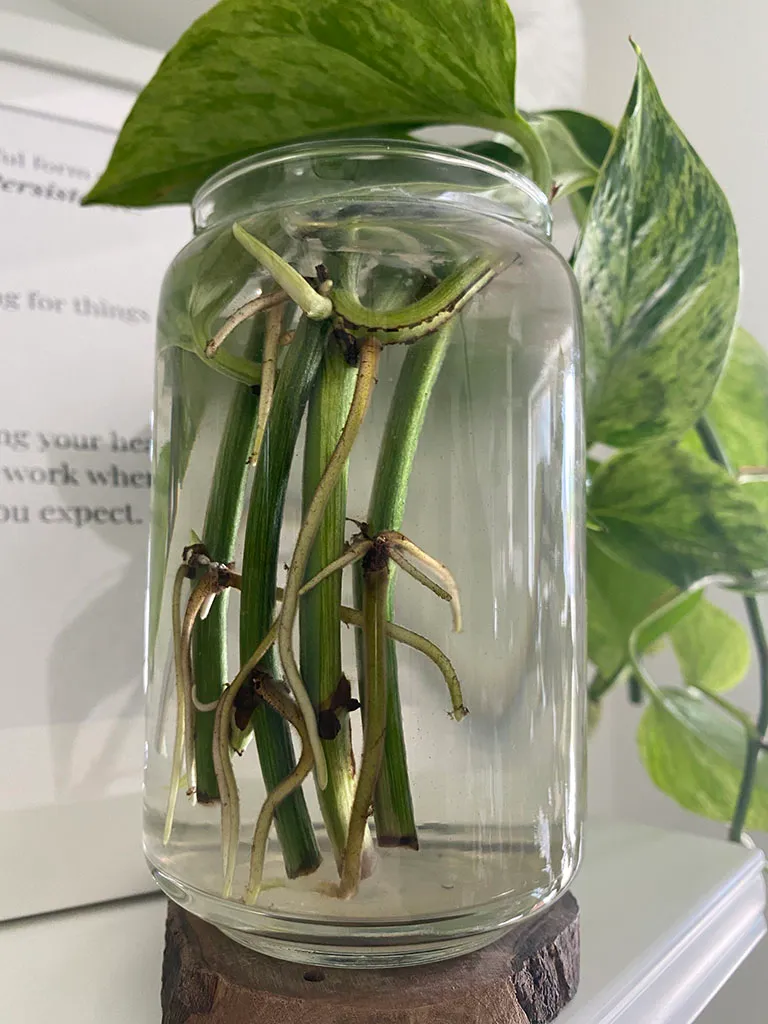Nurturing Your Pothos Plant
Growing Pothos in Water
Growing pothos in water is a straightforward and rewarding way to care for this resilient plant. Known for its heart-shaped green leaves, pothos, also referred to as devil’s ivy, is one of the easiest houseplants to propagate.
To start, take cuttings with 3-4 nodes and remove the lower leaves for longer stems. This encourages root growth when the cuttings are immersed in water. Pothos cuttings can survive temperatures as low as 50°F, with some hardier variants tolerating between 25°F (-3.9°C) and 30°F (-1.1°C).
Choosing the Right Vessels
The choice of vessel is crucial for growing pothos in water. Clean glass containers are recommended as they allow easy addition of water and effortless removal of the plant for cleaning (Instructables). Transparent vessels also enable you to monitor the water level and root growth.
To ensure the optimal growth of your pothos plant, follow these vessel selection tips:
- Material: Glass containers are ideal. They are easy to clean and keep the water quality high.
- Size: Choose a vessel that provides enough room for root expansion. Ensure the container can support the plant once it grows larger.
- Water Maintenance: Regularly change the water to prevent stagnation and algae growth. Using filtered water can help maintain better conditions for the plant.
By paying attention to these details, you’ll provide an environment conducive to thriving pothos plants. For additional care tips, including how to handle various watering schedules, visit our pothos plant watering guide. And if you’re interested in diving deeper into pothos plant care, check out our other articles on pothos plant problems and how to plant pothos.
Caring for Your Pothos Plant
Proper care is essential to ensure that your Pothos plant thrives when grown in water. Here, we will discuss the best practices for watering and fertilizing your Pothos to maintain its health and vibrancy.
Watering Pothos Plants
Watering is a crucial aspect of pothos plant care. When grown in water, it’s important to change the water every two weeks to prevent stagnation and reduce the risk of pests and diseases. You should use room temperature water to avoid shocking the plant’s roots.
Steps:
- Replace the water every two weeks.
- Use room temperature water.
- Rinse the roots during water changes to remove any debris or algae.
Fertilizing Pothos Plants
Even when grown in water, Pothos plants benefit from occasional fertilization. Using a water-soluble fertilizer diluted to half-strength helps provide the essential nutrients needed for growth without causing harm to the plant (Gardening Know How). Regular feeding is recommended to promote lush foliage and vibrant leaves.
Types of Fertilizers:
| Fertilizer Type | Frequency | Notes |
|---|---|---|
| Water-Soluble | Every 2-3 weeks | Dilute to half-strength |
| Slow-Release | Every few months | Low-maintenance option |
| Dry or Granular | Follow label instructions | Use at half-strength, not on dry roots |
Different fertilizers, such as dry or granular, can also be used, but should be applied cautiously to avoid over-fertilization. Slow-release fertilizer is a low-maintenance alternative, providing nutrients gradually over time. To prevent any issues, always follow the instructions on the fertilizer label.
By adhering to these watering and fertilizing guidelines, you can ensure that your Pothos plant remains healthy and continues to thrive. For more tips on Pothos plant care, you can visit our article on pothos plant watering and pothos plant fertilizing.
Ensuring Optimal Growth Conditions
Light Requirements for Pothos
Pothos plants thrive in bright, indirect light, but they can also tolerate medium to low indirect light. They are ideally placed near an East or West window for bright light, or a Northern window for lower light conditions. Direct, intense afternoon sun can damage the leaves, causing burning and browning. For more detailed information, you can visit our article on pothos plant light requirements.
| Light Condition | Suitability for Pothos |
|---|---|
| Bright, Indirect Light (East/West window) | Ideal |
| Medium to Low Indirect Light (Northern window) | Tolerable |
| Direct, Intense Afternoon Sun | Not Suitable |
Ideal Temperatures for Pothos
Pothos plants prefer temperatures between 65°F-85°F (18°C-30°C) and should not be exposed to temperatures below 60°F (15°C) to prevent cold damage (The Sill). Despite this, Pothos can survive slightly lower temperatures, with some sources indicating tolerance down to 25°F (-3.9°C) to 30°F (-1.1°C), although growth may slow in colder conditions.
| Temperature Range (°F) | Suitability for Pothos |
|---|---|
| 65°F-85°F (18°C-30°C) | Ideal |
| 50°F-60°F (10°C-15°C) | Tolerable |
| 25°F-30°F (-3.9°C to -1.1°C) | Minimum Survival |
To ensure optimal growth conditions, make sure to monitor the light and temperature levels in your home. For additional tips on pothos plant care, explore our related articles.
Propagation and Maintenance Tips
Propagating Pothos Cuttings
Propagating pothos plants in water is a straightforward process that requires a few essential steps. To get started, you need to take a healthy vine from an existing pothos plant and cut it just below a node. A node is the point on the vine where leaves and roots can grow. Ensure that the cutting is about 2-3 inches long and has at least one leaf attached.
Steps to propagate pothos cuttings:
- Cut the vine below a node.
- Remove the leaves below the node.
- Place the cutting in a vase filled with clean water. Submerge at least one or two nodes.
- Place the vase in indirect sunlight.
The roots will begin to sprout from the nodes submerged in water within 7-14 days. After the roots are well-established, which usually takes a few weeks to a couple of months, you can transplant the cutting into a pot with well-draining soil or keep it growing in water.
Dealing with Pests and Diseases
Pothos plants are generally hardy and pest-resistant. However, they can occasionally be affected by pests such as mealybugs. To keep your pothos healthy, it’s important to treat pests as soon as they appear. Regularly wipe down the plant’s leaves and employ a natural pesticide like neem oil or an insecticidal spray if necessary (The Sill).
Common signs of pest infestations and corresponding solutions:
| Pest Type | Signs | Solution |
|---|---|---|
| Mealybugs | White, cotton-like clusters | Neem oil spray, insecticidal soap |
| Aphids | Sticky residue, deformed leaves | Insecticidal soap, water spray |
In addition to pests, pothos can suffer from diseases if not properly maintained. Overwatering can lead to root rot, while underwatering can cause the leaves to curl and turn brown. To prevent these issues, regularly change the water every other week if the plant is in water and ensure it receives sufficient indirect sunlight. If grown in soil, water the plant every 1-2 weeks, allowing the soil to dry out between waterings.
For more information on pothos care, check out our guide on pothos plant watering and dealing with common pothos plant problems.




